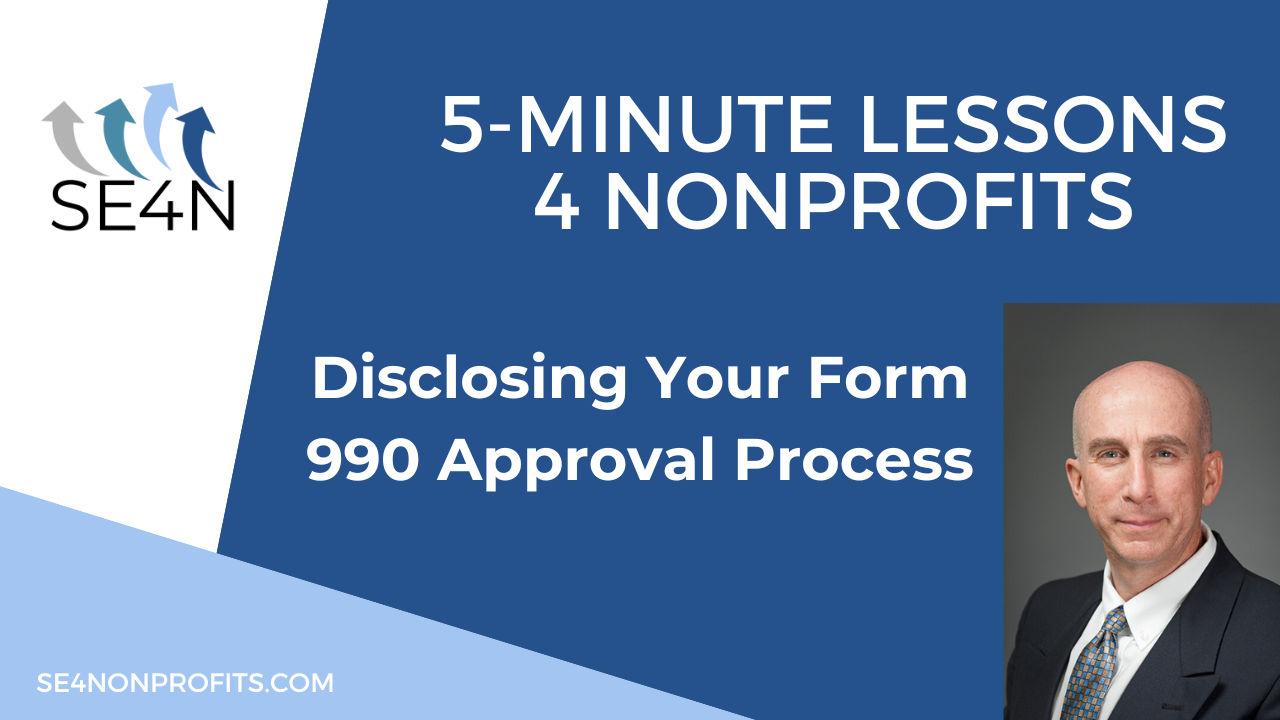
Blog.
Most Recent Posts
![TEMPLATE: Independent Contractor Agreement [SUBSCRIBERS-ONLY]](https://images.squarespace-cdn.com/content/v1/5e6ccadfb4659c1d51df14d5/9c548fca-b5f0-4ea1-8837-07d3ef70c66a/glenn-carstens-peters-ARpAUafeTp0-unsplash.jpg)
TEMPLATE: Independent Contractor Agreement [SUBSCRIBERS-ONLY]
This independent contractor agreement template contains basic provisions for situations in which nonprofit organizations hire consultants and other service providers on an independent contractor (Form 1099) basis. The template includes language intended to help support independent contractor treatment when appropriate, and covers key terms such as confidentiality, intellectual property rights, insurance, indemnification, and more.
![VIDEO PODCAST: Bylaws Tips for Nonprofits [SUBSCRIBERS-ONLY]](https://images.squarespace-cdn.com/content/v1/5e6ccadfb4659c1d51df14d5/ecc445a3-3161-430b-826c-b57f0fd0b363/SE4N+Video+Podcast+07.png)
VIDEO PODCAST: Bylaws Tips for Nonprofits [SUBSCRIBERS-ONLY]
Ben and Mike discuss tips and recommendations to help nonprofit organizations build better Bylaws, such as establishing a schedule for regular review of the Bylaws, complying with state law requirements, addressing Board meeting formalities, notice, and quorum requirements, clarifying term limits language, and more.

Q&A #164 – What happens if all Board member terms have expired?
It is unlikely that a nonprofit organization’s entire Board of Directors would be nullified due to a failure to hold elections, since most state nonprofit corporation statutes provide that Board service generally continues past the expiration of the Board member’s term until the Board member’s successor is elected and takes office. In the unlikely event that an organization truly has few or no Board members left to take action, there are often other mechanisms available under state law to reconstitute the Board or petition a court to appoint a legal representative.
![VIDEO Q&A for Subscribers: June 2024 [SUBSCRIBERS-ONLY]](https://images.squarespace-cdn.com/content/v1/5e6ccadfb4659c1d51df14d5/682f6ab6-6720-4d11-963f-45e952c5552b/SE4N+Video+Q%26A+2024-06.png)
VIDEO Q&A for Subscribers: June 2024 [SUBSCRIBERS-ONLY]
Ben and Mike answer questions from subscribers about the responsibility of a Board of Directors to fill vacancies and how vacancy appointments count towards term limits, the Board's responsibilities regarding the use of large unexpected gifts and bequests, whether Board service can be reported as an in-kind contribution, and the distinction between policies and procedures that apply to Board and the staff.

TEMPLATE: Labor Budget Worksheet
Labor costs are usually the largest expense line-item in a nonprofit organization’s budget. Preparing a separate labor budget is key to building a realistic and achievable budget for the next fiscal year. This labor budget worksheet will help you to view and manage the costs of staff salaries, employee benefits, and payroll taxes, show how these labor costs are expected to be allocated to programs, fundraising, and administrative (overhead) departments, and assist with aligning your organization’s budget with reporting requirements under generally accepted accounting principles (GAAP) and Form 990.

Remembering the Long-Term Purpose of Operating Reserves
No one questions whether it is important for nonprofit organizations to build and maintain adequate operating reserves. This is a best practice that is not only widely accepted, but also an expected goal for senior management and governance to pursue and protect. However, there often is a tendency to focus too much on the short-term reasons for building and maintaining operating reserves causing us to lose sight of the often more important long-term purpose for building operative reserves.
![VIDEO PODCAST: How and Why to Do Regular Financial Health Assessments for Your Organization [SUBSCRIBERS-ONLY]](https://images.squarespace-cdn.com/content/v1/5e6ccadfb4659c1d51df14d5/fc96aff6-62df-42c5-a117-105fba4d6baa/SE4N+Video+Podcast+06.png)
VIDEO PODCAST: How and Why to Do Regular Financial Health Assessments for Your Organization [SUBSCRIBERS-ONLY]
Ben and Mike discuss the importance of performing regular financial health assessments for a nonprofit organization, understanding the key components of an organization’s financial health and the appropriate financial health markers to track, how the Financial Health Assessment and Implementation Framework worksheet can be a valuable tool for your organization, and more.

Capital Budgets Play an Important Role in Nonprofit Planning and Budgeting
Annual operating budgets for nonprofit organizations will always hold center stage, drawing the attention of senior management, Board, and staff. However, this focus can often lead organizations to neglect longer-term sustainability, capacity, and cash flow planning issues. This is why capital budgets have an important role, serving as a synergistic complement to annual operating budgets that will help current and future planning.
![TEMPLATE: Basic Capital Budget Spreadsheet [SUBSCRIBERS-ONLY]](https://images.squarespace-cdn.com/content/v1/5e6ccadfb4659c1d51df14d5/43015284-66cf-477c-b331-ddc6275f41e0/laptops-7917663_1920.jpg)
TEMPLATE: Basic Capital Budget Spreadsheet [SUBSCRIBERS-ONLY]
Capital budgets are an important planning tool, helping nonprofit organizations to avoid problems from capital assets being used past their useful life, address future capacity challenges, and improve long-term cash flow planning. This basic capital budget spreadsheet template will help organizations to start tracking the acquisition and maintenance of their “capital assets,” i.e., material (larger dollar) assets that are expected to have a useful life of more than one year, such as computers, office furniture and equipment, leasehold improvements, and vehicles.
![Video Q&A for Subscribers: May 2024 [SUBSCRIBERS-ONLY]](https://images.squarespace-cdn.com/content/v1/5e6ccadfb4659c1d51df14d5/48a8fcb5-ca8a-44f0-98f1-93b2ca0d1081/SE4N+Video+Q%26A+2024-05.png)
Video Q&A for Subscribers: May 2024 [SUBSCRIBERS-ONLY]
Ben and Mike answer questions from subscribers about Board liability exposure, deciding whether a new organization should have a broad or narrow focus, how receiving more than $50,000 in revenue impacts an organization’s Form 1023-EZ, and when nonprofits should think about changing audit firms.
![VIDEO PODCAST: Using a Single-Member LLC as a Nonprofit Subsidiary [SUBSCRIBERS-ONLY]](https://images.squarespace-cdn.com/content/v1/5e6ccadfb4659c1d51df14d5/da414254-d2ac-4132-86df-df5a515e57d2/SE4N+Video+Podcast+05c.png)
VIDEO PODCAST: Using a Single-Member LLC as a Nonprofit Subsidiary [SUBSCRIBERS-ONLY]
Ben and Mike discuss tax, legal, and strategic considerations related to the use of single member limited liability companies (LLCs) by nonprofit organizations, including how and why nonprofits use this type of subsidiary structure, tips for drafting the Articles of Organization and Operating Agreement, and other issues such as charitable solicitation registrations and donor acknowledgment letters.

VIDEO: Disclosing Your Form 990 Approval Process | 5-Minute Lessons 4 Nonprofits
SE4N's A. Michael Gellman provides a short lesson on how to approach answering the questions about your nonprofit organization’s Form 990 review and approval process on Lines 11a and 11b on page 6 of the Form 990, Part VI, Section B, including a discussion of some of the various ways to distribute the final draft of the Form 990 to the Board before filing, which Schedule O disclosures are needed, and the importance of setting procedures and providing a clear timeline to the Board.
![Integrating Financial Health Assessments into Your Organization’s Planning Process [SUBSCRIBERS-ONLY]](https://images.squarespace-cdn.com/content/v1/5e6ccadfb4659c1d51df14d5/1715820960317-UWXTFUHFXCN1WXBX38SW/marek-studzinski-mmzuzrieEXg-unsplash.jpg)
Integrating Financial Health Assessments into Your Organization’s Planning Process [SUBSCRIBERS-ONLY]
The markers for tracking and assessing a nonprofit organization’s financial health are not a mystery. The key elements of financial health (operating reserves, funding, and operational expenses) are generally easy to identify and understand. You just need a willingness to keep your eyes open and a commitment to pause and make an honest assessment of a financial picture that has most likely been changing.
![WORKSHEET: Financial Health Assessment and Implementation Framework [SUBSCRIBERS-ONLY]](https://images.squarespace-cdn.com/content/v1/5e6ccadfb4659c1d51df14d5/48a2d35c-486b-46e5-94fa-d782fda3de9f/isaac-smith-CbXmEkOrzSg-unsplash.jpg)
WORKSHEET: Financial Health Assessment and Implementation Framework [SUBSCRIBERS-ONLY]
The purpose of this Financial Health Assessment and Implement Framework worksheet is to help you to step back and assess your organization’s recent financial position and set the stage for planning the next two years. This worksheet will help you to look back at recent history while looking forward to create a path to improve your organization’s financial health and enhancing sustainability.

Q&A #162 – Can nonprofit volunteers deduct the value of their services as a charitable contribution?
The value of a volunteer’s time for in-kind services donated to a nonprofit organization is not tax deductible, and an organization should never state the dollar value of a volunteer’s services in an acknowledgment letter. However, it may be appropriate to provide volunteers with an acknowledgment letter that generally describes the services they provided so that volunteers can deduct certain eligible unreimbursed expenses.